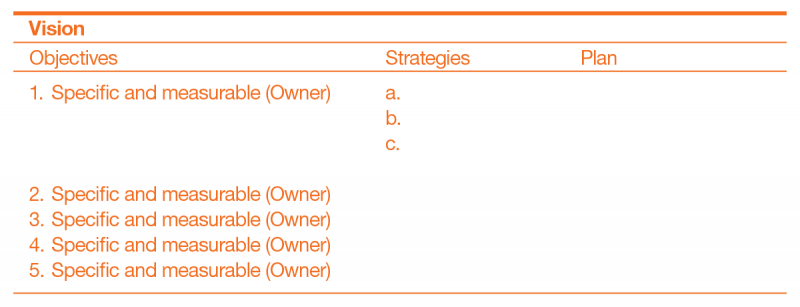I love strategic planning.
When done well, at the right time, it’s useful and clarifying.
When done poorly, or at the wrong time, it’s soul-sucking. Instead of accelerating your business, it can grind it to a halt.
A quick web search will turn up many strategic planning resources, all describing the same elephant. Thankfully there is a general consensus about what a strategic plan is and does.
Some of those readily-available frameworks are quite detailed, and in certain contexts, those details can be valuable. My tools however tend to be simple.
Here is a format and conceptual process for strategic planning that I’ve found works well for businesses of all kinds.
The why
A strategic plan helps an organization optimize its efficiency and impact.
The when
It’s usually created when:
- You realize your business does not have a strategic plan.
- You are reaching the end of the previous strategic plan.
- You must react to major external or internal shifts.
- You are choosing proactively to grow or change the business.
The what
Here is what a final strategic plan includes, and how the pieces knit together:

It can be shared on a wall, in a Google Doc, or via a sophisticated online dashboard or task management system. It might have deeper details, but the basic template is the same for all organizations, in any situation.
Step 1—Start with Vision
Vision is where most organizations lose the way.
Vision tells everybody internally where you’re headed.
Vision is not a lofty and vague aspiration or a pleasant fantasy about the future.
It is either:
- An ambitious, measurable, time-delimited goal
- A short description of the disruptive innovation you intend to create
- An honest answer to the question: “What do you want?”
If a vision is not articulated, then a secret one is at work. Examples: “Preserve the internal culture at all costs” or “Just get through the year.”
If your vision is primarily about your internal systems, not your external impact, then you have a hobby, not a business.
Step 2—Define Objectives
Choose 4-7 objectives—really, no more—that support your vision, capturing all the major functions of your organization: current services, operations, marketing, culture, experiments, etc.
Make sure each objective is measurable, meaningful, and doable. The time horizon will vary depending on your unique situation.
Then, assign a clear owner for each objective. This usually provokes some epiphanies regarding your organizational structure.
Step 3—Choose Strategies
Identify 1-5 strategies that you will use to accomplish each objective.
Strategies ideally are not simple tasks that can be accomplished in an afternoon. They should be complex initiatives that will last for at least a few months.
Assign an owner to each strategy. And then:
For each strategy you must define not only how you will know if the strategy was executed but also how you will know if it was successful.
If you skip this very important step, your strategic plan turns into an endless list of to-dos. Some strategies will fail, and those failures will be educational. If all of your strategies are sure to succeed, you are likely being too naive or too conservative about your business growth.
Step 4—Develop the Plan
Identify the key activities and milestones needed to accomplish and assess the strategies. The plan can be to whatever level of detail and in whatever format makes sense for your business. Typically, it’s a Gannt chart.
The how
The shell above is the one I would use and populate for all organizations. Larger organizations will require deeper and more sophisticated content—for example, calling out critical success factors for each objective—but the template is the same regardless.
Most of the important variations you see between different strategic planning approaches are not about the outline, but the process used to populate it. One reason for this is that many organizations use strategic planning as a mechanism to align people and generate insights.
Here it’s important not to a follow someone else’s methodology blindly. Enrolling and aligning people and coming up with great new ideas can take place as part of strategic planning, or separately. I’ve seen highly successful strategic plans that were imposed by a CEO with little input or collaboration, and ones built iteratively through complex, multi-stakeholder engagement models that completely failed.
Generally speaking, there is no process that will compensate for a weak leader, a shortage of good ideas, a lack of useful and actionable information, or a failure to implement usable management tools.
The “how” can vary not only based on organization’s size and maturity but also its type. The Wikimedia Foundation has modeled how to do strategic planning with large networks, with a resulting direction that’s both “bottom-up and outside-in.” The Transition Town movement has articulated a great process for strategic planning with communities. I’ve written about these different organization types before: they allocate and optimize power in ways that are very different from traditional, closed organizations. And a growing number of organizations these days are hybrids—e.g., a private company that is porous to a network that it incubates, or a public institution that is inter-dependent with a larger community.
Optimizing your strategic planning process for efficiency, inclusiveness, consensus, or emergence might make sense or it might not depending on your circumstances.
When in doubt, look for an experienced facilitator who is aware of multiple different methods who can make a custom and context-appropriate recommendation.


Leave a Reply